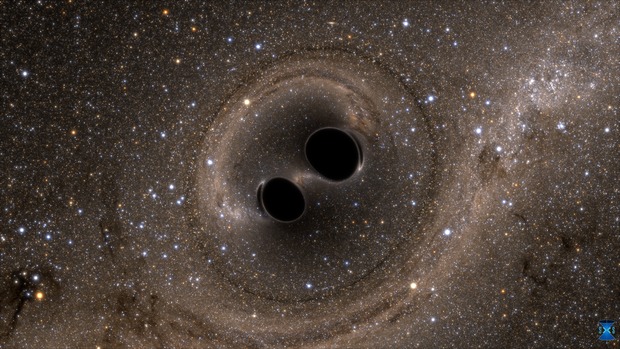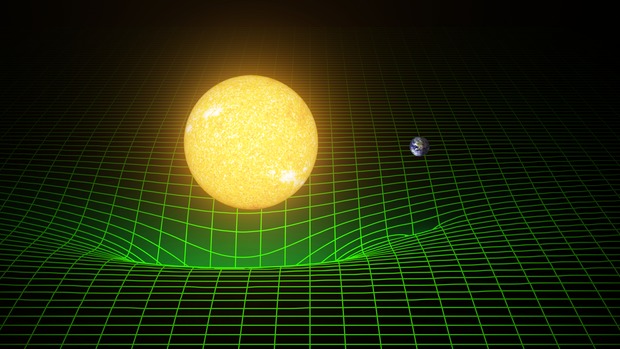One of the biggest discoveries in our lifetime has been made which could help scientists answer some of their biggest questions

A screen shot from a computer simulation showing two black holes about to collide.
A shot from a computer simulation shows two black holes spiralling towards each other, eventually colliding and merging into one. The gravitational waves caused by the event were detected by LIGO with the help of CSIRO and a number of Australian universities. Image credit: LIGO, SXS
Astronomers have found something and it’s kind of a big deal. Actually, it’s more like one of the biggest discoveries in our lifetime has been made which could help scientists answer some of their biggest questions – what is the universe made of? Are there other universes?
For the first time in history, astronomers have observed elusive gravitational waves – ripples in space time caused by a violent cosmic event taking place in the distant Universe. This discovery will not only open a new window into the cosmos, but it also proves Einstein’s prediction from 100 years ago.
The announcement was made today in Washington by the Advanced Laser Interferometer Gravitational-wave Observatory (LIGO) in the US, which comprises two giant detectors that are 4km long and 4000km apart housing the most sensitive equipment ever made.
Physicists have concluded that the detected gravitational waves were produced during the final fraction of a second of the merger of two black holes to produce a single, more massive spinning black hole.
In order to aid the hunt for gravitational waves, LIGO recently received $200M worth of upgrades. One of the major components of this was the installation of ultra-high-performance optical mirrors, many of which were coated by our researchers.
Dr Cathy Foley, Science Director of CSIRO Manufacturing, said that the upgrade of the LIGO detectors increased the sensitivity of the system by around 10 fold.
“Through the use of interferometry, which is the merging of two sources of light, LIGO is designed to measure changes between the two arms of each detector. The two giant detectors, which are located on opposite sides of the US, are then compared to confirm the findings,” Cathy said.

Image showing Sun and Earth with grin grid below bending - demonstrating warping by gravity.
Space time (represented here with a greeen grid) is warped by massive bodies, such as the Sun and Earth. Einstein’s theory predicted existence of gravitational waves, which are ripples in space and time. These waves, which move at the speed of light, are created when massive bodies accelerate through space and time. Image credit – LIGO
“The interferometer system includes a series of mirrors which are coated with multiple precisely controlled layers of optical materials to give the required reflective properties and lastly a top layer of gold, designed for thermal shielding.
“The coatings, which were developed and applied at CSIRO, are among the most uniform and highly precise ever made. This precision ensures that LIGO’s laser remains clean and stable as it travels through the detectors.
Scientists from CSIRO have joined in with a number of Australian universities who also assisted LIGO, to celebrate the monumental discovery today.
Dr Simon Johnston, Head of Astrophysics at CSIRO, explained why this is an immensely important discovery for physics and astronomy.
“Gravitational waves exert a powerful appeal. Back in 1915 Einstein proposed that space-time is a four-dimensional fabric that can be pushed or pulled as objects move through it.
“If you run your hand through a still pool of water waves will follow in its path, spreading throughout the pool.
“Now that we’ve caught these waves, we can use them to see the Universe in entirely different ways to what was previously possible.”
The discovery accepted for publication in the Physical Review Letters journal, was made by the LIGO Scientific Collaboration.
The Australian Partnership in Advanced LIGO was led by Australian National University. Scientists from CSIRO, the University of Adelaide, The University of Melbourne, the University of Western Australia (UWA), Monash University and Charles Sturt University, also contributed to the discovery.


16th February 2016 at 9:57 pm
A brilliant piece of work that, along with the hadron collider, planetary explorer robots and manned space missions, is about a thousand years too early to be justified. This is Sabbath Science, of no practical help in Earth and compounding humankind’s present social, environmental, biodiversity and climate crises by consuming far too much of the resources available for studying real problems.
The evidence to study the infinite complexity of the remote cosmos will still be there if humans are in a thousand years time. At the current rate of species extinction however, Earth’s ecosystems will be depleted, irreversibly destroying opportunities to study the fragile and truly wonderful phenomenon of life.
15th February 2016 at 6:23 am
I think $200 million could have been better spent feeding the world and trying to reverse the amount of environmental damage humans have done to our planet!
16th May 2016 at 6:16 pm
Well, that’s not entirely incorrect, actually, it’s very logical. But science is very ‘cool’ as well. (@ @)
——
14th February 2016 at 7:43 am
Brilliant everyone. Go science!
Pingback: Allgemeines Live-Blog ab dem 12. Februar 2016 | Skyweek Zwei Punkt Null
12th February 2016 at 5:14 pm
I watched half of it live when I found out about it.